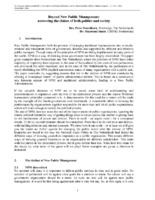Mostrar el registro sencillo del ítem
Beyond New Public Management: answering the claims of both politics and society
| dc.contributor.author | Noordhoek, Peter | |
| dc.contributor.author | Saner, Raymond | |
| dc.date.accessioned | 2018-09-02T05:32:40Z | |
| dc.date.available | 2018-09-02T05:32:40Z | |
| dc.date.issued | 2004-11 | |
| dc.identifier.uri | http://cladista.clad.org//handle/123456789/3310 | |
| dc.description.abstract | New Public Management held the promise of changing traditional bureaucracies into a results-oriented and transparent form of government, directed and supported by efficient and effective public managers. Though many of the principles of NPM are being implemented in many parts of the world, NPM as a way of thinking about government has been largely discredited. This paper gives examples from Switzerland and The Netherlands where the premises of NPM have either explicitly or implicitly been rejected, in the case of Switzerland by the votes of two parliaments, one provincial the other municipal, and in the case of The Netherlands by the publication of a report abolishing the NPM-inspired autonomous status of many organizations with a public task. The paper concludes by suggesting reasons that led to the decline of NPM and concludes by offering a 'conceptual restart' of public administrative reform. This is based on a constructive mix between aspects of NPM and traditional administration, leading to a New Public Administration. | |
| dc.description.abstract | If the valuable elements of NPM are to be saved, some kind of understanding and accommodation is imperative with the role of the democratic process and the classic Weberian bureaucratic principles connected to it. A demonstration for this need for a restart will be made by the example of the Dutch government wide benchmark. A remarkable effort of showing the performance by organizations together responsible for more than half of all public expenditures, which still is not enough to satisfy the political process. | |
| dc.description.abstract | The end of NPM does not mean the end of the improvement of public organizations. Ignoring the classic political hierarchic way of getting things done is not an option, but neither is getting back to old mechanisms of power and distrust. There is need - an urgent need - for a conceptual restart. To do so, several elements should be considered. These have to do with trust and distrust, with building relations and rational concepts. We show how it can work - or at least we will give you the reader an A-B-C agenda for changing the public sector after the demise of NPM. Examples are found in the way the National Audit Office in The Netherlands had linked the different ways of showing yourselves responsive as a public organization. This means different ways of showing yourself responsive as an organization for different stakeholders. This starts with the parties in the democratic process, but it goes further than this. What does this mean for the future, by what rules of the game will we play? Some examples are given, a direction is indicated. | |
| dc.format.extent | 16 p. | |
| dc.language | Inglés | |
| dc.publisher | Northedge | |
| dc.rights | Creative Commons BY-SA-NC 4.0 Int | |
| dc.rights.uri | http://creativecommons.org/licenses/by-nc-nd/4.0/ | |
| dc.subject | CONGRESO CLAD 9-2004 | |
| dc.subject | MODERNIZACION DE LA GESTION PUBLICA | |
| dc.subject | GESTION POR RESULTADOS | |
| dc.subject | PROPUESTA | |
| dc.title | Beyond New Public Management: answering the claims of both politics and society | |
| dc.type | article | |
| clad.congress | Congreso Internacional del CLAD sobre la Reforma del Estado y de la Administración Pública, 9 -Documento Libre | |
| clad.key | MFN35650--35650 | |
| clad.key1 | KEY35650 | |
| clad.md5 | db8bf700d3ee9e9b69359233b2f038c0 |


